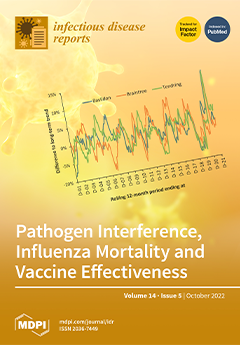Open AccessArticle
Stress Hyperglycemia Ratio as a Prognostic Marker in Diabetic Patients Hospitalized with COVID-19
by
Mohamed Aon, Abdullah Alsaeedi, Azeez Alzafiri, Abdelrahman Al-Shammari, Sherif Taha, Omar Al-Shammari, Mahmoud Tawakul, Jarrah Alshammari, Naser Alherz, Monerah Alenezi, Meshari Eyadah, Mariam Aldhafeeri, Teflah Alharbi, Duaa Alshammari, Zaid Alenezi, Salem Aldouseri, Ebraheem Albazee, Mohamed M. Ibrahim and Ahmed H. Aoun
Cited by 13 | Viewed by 3944
Abstract
Evidence is conflicting about the diabetes characteristics associated with worse outcome among hospitalized COVID-19 patients. We aimed to assess the role of stress hyperglycemia ratio (SHR) as a prognostic marker among them. In our retrospective cohort study, patients were stratified according to SHR,
[...] Read more.
Evidence is conflicting about the diabetes characteristics associated with worse outcome among hospitalized COVID-19 patients. We aimed to assess the role of stress hyperglycemia ratio (SHR) as a prognostic marker among them. In our retrospective cohort study, patients were stratified according to SHR, admission glucose, and glycated hemoglobin tertiles. The primary outcome was a composite endpoint of invasive mechanical ventilation, intensive care unit admission, and in-hospital mortality. The study included 395 patients with a mean age of 59 years, and 50.1% were males. Patients in the third tertile of SHR developed more primary events, and the difference was significant compared to the first tertile (
p = 0.038) and close to significance compared to the second tertile (
p = 0.054). There was no significant difference in the outcomes across admission glucose and glycated hemoglobin tertiles. A higher SHR tertile was an independent risk factor for the primary outcome (OR, 1.364; 95% CI: 1.014–1.836;
p = 0.040) after adjustment for other covariables. In hospitalized COVID-19 diabetic patients, SHR third tertile was significantly associated with worse outcome and death. SHR can be a better prognostic marker compared to admission glucose and glycated hemoglobin. A higher SHR was an independent risk factor for worse outcome and in-hospital mortality.
Full article
►▼
Show Figures






